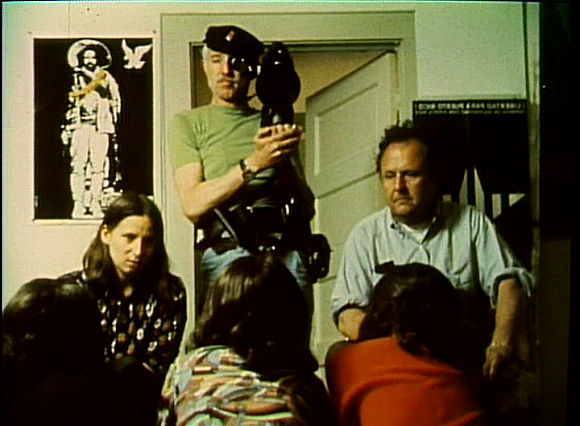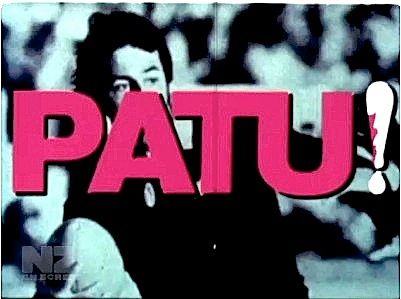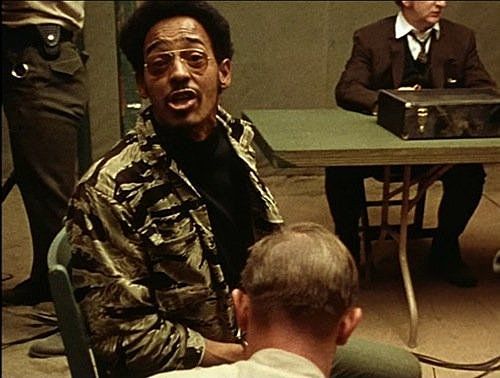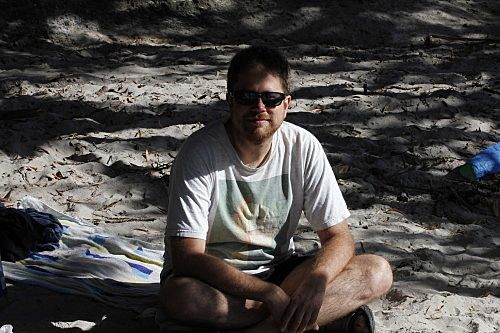Resistance Cinema in a Seller's Market
In a polemical world, is good documentary withering?
In a polarised post-truth world, is there room for good documentary? Doug Dillaman delves in the archives for inspiration in this strong polemical plea for keeping our minds open.
Several months ago, after the election of a certain shitgibbon, I found myself in a trough of hopelessness regarding our political future, and thinking the only way out of it was to write a thinkpiece on political documentaries and resistance cinema. This is of course the intelligentsia equivalent of baking an American flag cake after 9/11. One difference? People get excited when they see a cake.
That my impulse was to write about film, rather than make a film to advocate for a political future, speaks to a larger despondency I have about discourse and how cinema does (or doesn’t) facilitate that. Such despondency may seem strange. Measured by herd strength, political documentaries couldn’t be stronger – there’s a gazillion of them. Thanks in part to the democratisation of filmmaking tools, no issue is too niche to garner its own film, and compelling documentaries can reach large audiences. They can even make a tangible difference. 2013’s anti-whale captivity documentary Blackfish, for instance, sparked a campaign so damaging to Sea World that the company ended orca shows at all of its theme parks. “The Blackfish effect” has entered common parlance.
So what’s the problem? Where to start? How about with this: Blackfish is propaganda and a terrible film to boot, clumsily manipulative in its structure and ludicrously disingenuous in its self-declared even-handed approach. Hot tip: you can’t use ominous musical drones over scenes relating to one side and convincingly claim neutrality. (For a detailed and educated dismantling, check out Michael Sicinski and Jennifer Wingard’s piece for Nashville Scene.) Did Blackfish effect change for a great purpose, a purpose that I (from my wildly uneducated perspective) agree with? Sure. It’s still a bad, dishonest film. To call it otherwise, even if you agree with it, is to support dishonest discourse. And don’t we have enough of that already?
Awareness-raising, ‘impact’-oriented documentaries try to stir audiences into action, but secretly, they make people feel as if they’ve done a good deed by simply bearing witness. – Chris Boeckmann
Here’s the ugly truth: we don’t communicate with our ideological adversaries, not in person, and certainly not with our films. (Saying “you’re wrong”, “you’re stupid”, and/or punching somebody in the face is not communication, and if you’re serious about changing somebody’s mind, these are not useful tactics, no matter how righteous they make you feel. Research says so.) The result of only preaching to the choir is a blind partisanship that only becomes more entrenched with every new bit of media that supports your own confirmation bias, whatever that may be. Inevitably, it means that cinematic works are valourised for the stridency of their beliefs, not for their insights. Propaganda wins. And thoughtful audiences lose. There’s too much cinema around that doesn’t acknowledge the failures and limitations of its necessarily imperfect subjects. And there is too much cinema around that is principally about the sale of an ideology, rather than creating a space to upend one’s preconceptions.
During the process of writing this article, trying to make sense of my despondency, I stumbled across “Projecting Outside the Echo Chamber”, an article/primal scream by documentary programmer Chris Boeckmann published in Filmmaker Magazine. He shares many of my qualms with contemporary documentary cinema and has quantifiable experience to back it up from his work. Money quote: “It hurts to admit this, but after five years of earnest programming, I’ve come to the conclusion that I have wasted my time, and I suspect others’ as well.” Another money quote: “Awareness-raising, ‘impact’-oriented documentaries try to stir audiences into action, but secretly, they make people feel as if they’ve done a good deed by simply bearing witness.” There’s lots more where that came from.
Blackfish and many other films – Before The Flood, Minimalism, pretty much everything I’ve seen by Alex Gibney (Going Clear, Enron: The Smartest Guys in the Room, etc etc etc) – are symptomatic of what Boeckmann bewails, a trend so pervasive, it’s essentially the default: the documentary as commercial. I mean this in both ideological and formal ways. These films exist to sell their ideas, and everything in each film is in subservience to the sales job. And in order to do so, they borrow from the manipulative cinematic language of advertising in myriad ways. I would never argue that documentary film is no place for passionately partisan ideas, passionately argued. But when I see ideas I agree with presented in a form I find repugnant, I can only imagine how people who disagree with the ideas react.
Nearly half of viewers on IMDb gave Hillary’s America a perfect 10…. The next highest score was 1. In audience response, as in the film itself, there’s no room for nuance.
Am I picking on the left? It’s not like they’re solely at fault: there’s plenty of dire right-wing documentaries, and none are more prominent than Dinesh D’Souza’s string of Democrat-bashing films, culminating in 2016’s Hillary’s America. Those last two words link to a trailer, which is all I’ve seen of the film, and more than enough to convince me it’s laughably terrible, regardless of ideology. It makes Blackfish look austere, Minimalism look objective, and Donald Trump look reasonable. It’s the eighth highest grossing political documentary in US history, earning $13 million at the US box office. The number of viewers far outstripped Trump’s margin of victory in a few key states, and D’Souza was all too ready to take credit for said victory. Nearly half of viewers on IMDb gave Hillary’s America a perfect 10. For so many viewers, it’s only the message, not the medium. The next highest score? The lowest possible score: 1. In audience response, as in the film itself, there’s no room for nuance.
I know, I know. In 2017, asking for nuanced cinema that withdraws from the language of advertisement feels roughly equivalent to asking for the return of the radio play, or extolling the virtues of the horse-drawn carriage, or advocating for oil-burning lamps. Making a marketing plan before you’ve made the film is de rigueur, sponsored content is part of the game, and leaving room for you to learn and discover during the filmmaking process is not an opportunity but a danger to be avoided lest it complicate your thesis. And, most recently, looking slick isn’t selling-out but a default mode of expression. Superficial beauty can be achieved on even a modest budget in these times, where we all have in our pockets video cameras of substantially higher resolution than those used by most documentary makers a mere 15 years ago. And now we can reach viewers around the whole world for negligible costs through the internet. The game has changed, and it ain’t changing back.
Leaving room for you to learn and discover during the filmmaking process is seen not as an opportunity but a danger to be avoided lest it complicate your thesis.
***
But for what we’ve gained with technology, have we lost more? I decided to dust off some older examples of what is often referred to as “resistance cinema”. Sometimes documentary, sometimes dramatic, and sometimes combining the two in exciting ways, resistance cinema is a loose tent, unified by the commitment of socially-committed filmmakers who see their films as part of a greater movement towards social change. The older films can be strident to the point of didacticism, and they can be primitive not just by modern standards but standards of the time. But they also carry an urgency that feels unencumbered by the desire for a beautiful façade. Perhaps a closer look reveals what’s missing today.
I started with Underground, an immersive profile of the Weather Underground filmed in 1975. Born of the peace movement and inspired by militant African-American groups like the Black Panthers, the group conducted a series of bombings directed largely at government buildings. The bombings started in 1969 and were still in progress during the making of the film. (Whether the Weather Underground are to be considered terrorists or militant resistance is a matter of debate, though it’s worth noting that no civilians were harmed in their bombings, as the group would warn of their attacks in advance.) For reasons of self-protection, the Weather Underground refused to appear on camera, so much of the film is interviews shot into mirrors that reflect the crew and the back of their heads, or interviews depicting the group in silhouette, or behind scrims, as the four subjects pontificate at (great) length about their inspirations, actions, and visions of a radicalised future America where the working class rise up.
By and large, the film is not a great model for contemporary filmmaking; it’s hard to imagine a modern audience having the patience for so much unglossy, unmediated revolutionary pontification. Those interested in the group might want to begin with 2002’sThe Weather Underground, a much more traditional retrospective documentary by Sam Green. Still, the 1970s’ Underground (a film collaboratively credited to Emile D’Antonio, cameraman Haskell Wexler, and Mary Lampson, the three filmmakers who often appear in frame in lieu of its subjects) is unexpectedly striking when it hits the limits of its form. One particularly gripping sequence occurs when its subjects start to question the actual purpose of the film. “We're struggling to find the form of what we're doing … All of this [filmmaking] equipment is contradictory. It can be used by the ruling class or the working class.” Finally, they ask D’Antonio himself what the best way is to make a film that moves other people. “By telling us how you got there” is his reply, and so they do.
This sort of active, visible process isn’t just meta-buffoonery. It’s about presenting the film as something that isn’t pre-determined – not in a crappy, faux-naïve way like Blackfish, but an actual, real-time interrogation of motive and purpose. And in doing so, when the sloganeering of the film re-emerges, it lets the viewer freshly interrogate the ideas, and know that if they come to accept them, they have done so without naked manipulation. And if they choose not to accept those ideas, they come away with a greater sense of the Weather Underground as human beings, rather than as sloganeers.
Another film that blurs the line between filmmaker and activist is one of New Zealand’s finest. Merata Mita’s Patu! (1983) documents the lead-up to the 1981 Springbok tour of New Zealand, as a grassroots anti-apartheid movement gradually gained force. Mita details the process in all its particulars both small and large, from meetings and pamphleteering to demonstrations, and finally, direct action. As the Springboks arrive in New Zealand, resistance rises, escalating to conflict in the streets, rugby games stopped by flour bombs, and more. While it’s fundamentally an endorsement of the anti-Tour movement, Patu! doesn’t shy away from acknowledging the ugly truth that some were attracted to the protests principally for the chance to unleash their more violent impulses.
The final credits of Patu! play over a Māori street march, implicitly asking the viewer to channel any sense of injustice they may have regarding the Springbok tour into similarly racial injustices here in Aotearoa.
To acknowledge the weaknesses of one’s own movement while still arguing with a strident voice for the larger justice of one’s cause is a rarity in today’s political environment, with liberals largely willing to brush off antifa and anarchist violence and conservatives often willing to tolerate their racist and Nazi extremists. This blindness to the failures committed in the name of one’s own cause may seem like a necessary evil in order to display strength, but in our current environment, it proves a barrier to communication. Mita’s argument for the justness of the anti-Tour movement – and a larger protest movement in general – is in no way weakened by her warts-and-all portraiture, and is also a major reason why the film endures in a way few “issue documentaries” do. (The whole film is available for free viewing at NZ On Screen.)
One particular strength of Patu! – one Mita copped some flak for – is situating the resistance of an event inside a longer tradition of Indigenous resistance. The events of Patu! occur a few years after the Bastion Point protest (which Mita also documented in the elusive Bastion Point Day 507), a galvanising flashpoint for protest in this country. (Strikingly, Underground also acknowledges its subjects’ protest antecedents: the anti-war movement’s debt to activists such as Malcolm X, H. Rap Brown, and Fred Hampton.) Throughout Patu!, there is a strong acknowledgement of the Māori involvement and presence in what has often been considered to be a largely Pākehā movement. The final credits of Patu! play over a Māori street march, implicitly asking the viewer to channel any sense of injustice they may have regarding the Springbok tour into similarly racial injustices here in Aotearoa. It’s a complicated inclusivity that acknowledges the long-term work of political resistance, divorced from the “Problem? Solution!” suggestivity of so many contemporary issue documentaries.
It’s that inclusivity that may point to the most easily-adapted plastic virtue of Patu!: its collaborative nation-wide creation. While film is intrinsically a collaborative medium (and the contributions in particular of editor Annie Collins should not be overlooked), Mita’s solicitation of footage of protests and direct actions from across the country brought together a tapestry of voices more rich than any one filmmaker could have filmed on her own. In this era of digital ease, the notion of bringing filmmakers together from all over the world does sometimes happen, most famously in the Ridley Scott-produced crowdsourced Life in a Day. But many of the failures of contemporary documentary occur in part because of blinkered points of view. By collaborating with other filmmakers, does a documentarian risk having their point of view diluted? Patu! suggests the opposite: many eyes can see more than one ever could.
Watkins makes no efforts to make his protagonists especially likable to the mainstream, or even acceptable – one particularly strident songwriter is painfully shrill and unrepentantly pro-bombing.
In recent years, there’s been much hype around “hybrid” filmmaking that combines documentary and drama. This is probably good branding, but it’s merely new packaging for an old technique: documentary makers have been staging scenes and using dramatic techniques forever, and drama filmmakers have introduced “reality” into their films in countless ways. One particularly intriguing era for this is the late 60s and early 70s. Drama directors, besotted with revolutionaries, found different ways to integrate them into films. Jean-Luc Godard allowed Black Panthers to speechify at great length in Weekend, while Underground cameraman Haskell Wexler went on to direct Medium Cool, which sets a fictional scenario at the very real 1968 Democratic National Convention. But my favourite film of the era – one of my favourite all-time films, in fact – is 1971’s Punishment Park.
Peter Watkins, the director of Punishment Park, is a committed revolutionary in many ways. Long before my qualms with the commercial texture of documentary, he railed against “monoform”, his term for the standard documentary approach which provide sound bites and give no air for viewers to question ideas. His later films deal to this using, among other techniques, increasingly lengthy run times – 1987’s The Journey, a “global peace film” that travels the world exploring nuclear technology, clocks in at 14 ½ hours. I respect his commitment, but in an era where a 4-minute short film is “too long”, I’m not sure that his work has a place in mainstream dialogue - unless he could repackage it for binge watching on Netflix, of course.
But once upon a time, Watkins put his politically revolutionary ideas in more conventional form, and the results were electric. Punishment Park imagines an America where the President has powers to seize those who are considered to be risks to national security and subject them to secret tribunals where the Constitution does not apply (a scenario that is all too realistic). Those found guilty – all of them, unsurprisingly – are given the choice of jail time or three days in Punishment Park, a harsh desert training camp for law authorities. The film ping-pongs between a tribunal, a set of prisoners on the run, and the authorities preparing to chase them. This creates a formal framework in which the strident messages so characteristic of the cinema of resistance are condensed to propel the story, and are given urgency by the dramatic setting.
Josh Begley’s Best of Luck With The Wall uses no words to make its argument but simply uses satellite imagery – 200,000 images from Google Maps, to be precise - to traverse the entire US/Mexico border.
Largely improvised, with a cast largely consisting of non-professionals, Punishment Park uses its high-concept as a framework for its ideals, allowing its young revolutionary cast to make their own arguments in their own language. Watkins makes no efforts to make his protagonists especially likable to the mainstream, or even acceptable – one particularly strident songwriter is painfully shrill and unrepentantly pro-bombing – but in making some of the advocates of the system “reasonable” by comparison, he actually dismantles our confidence in reasonable-sounding solutions, showing that “reasonable” apologists can perpetrate horror and injustice. Even when the camera crew enters the narrative, Watkins manages to depict a range of humanity in the oppressors, showing the perpetrator of one atrocity not as a hardened advocate of the system but a confused young man. This is just one example of his knowing understanding of both the spectrum of complicity and spectrum of resistance. In a time where nuance is sorely lacking in our discourse, Punishment Park shows that you can be both forceful and nuanced.
***
I suspect that, for all my appreciation of their virtues, films like Underground and Punishment Park had little exposure to those who hadn’t bought in to their ideological message. Today, the ideal of the internet is that a film can reach anyone, and while the past twelve months have taught us much about the barriers of social media bubbles, it’s not implausible to think that the right kind of film, one whose message is subsumed in a non-propagandistic form, could cut through the noise and affect change. Josh Begley’s Best of Luck With The Wall, a short film produced by Field of Vision (co-founded by Citizenfour director Laura Poitras), deserves special consideration as a film which combines force and nuance with an attention to aesthetics that short-circuits the commercial documentary feel. (If you have seven minutes to spare, view it here.) It uses no words to make its argument but simply uses satellite imagery – 200,000 images from Google Maps, to be precise - to traverse the entire US/Mexico border. Best of Luck implicitly asks us to imagine the difficulty involved in the creation of Donald Trump’s pet project, seducing us with beauty and overpowering us with the sense of impossibility all at once. Its aesthetics are simultaneously modern and harken back to avant-garde cinema pioneers: I thought of the relentless imagery of Stan Brakhage’s Mothlight (1963), which was made by securing dead insect wings to celluloid and projecting the results.
Not all subjects, however, befit such an aggressively experimental approach. What then?
Well, it turns out stepping outside comfort zones can go a long away. The most exciting new film – documentary or otherwise – I’ve seen recently is one that upends viewer expectations entirely with incredibly modest aesthetic means. Chris Boeckmann recommends it in “Projecting Outside the Echo Chamber” is Stranger in Paradise, and it is playing this year’s DocEdge festival in Auckland and Wellington. I inveigled my way into a screener, in part for my new monthly film newsletter, and possibly in larger part with the hope that it would be the tonic that Boeckmann suggested it might be.
Oh, man. My recommendation is that you go see Stranger in Paradise with no foreknowledge and skip the next two paragraphs.
After a pyrotechnic opening montage that contextualises the problem of migration and refugees in the larger history of cinema and the world, things appear to settle down to something much more conventional, as a Dutch man meets a group of prospective migrants to Europe in a classroom somewhere in Europe’s south. It seems at first that he’s there to welcome them, but increasingly, it becomes clear his aims are something else entirely. Meanwhile, the migrants are in turn free to respond in whatever way they see fit. It’s a bracing clash of ideals put forth with a provocateurism that reminded me, ever so slightly, of what might happen if Lars von Trier were asked to make a documentary on the topic.
And then, just when you think you can’t take it anymore, the second act begins, and it’s the same, except with a new class, and the same man – who is now espousing an entirely different ideological argument, one that its probable (left-leaning) viewers are likely to find more sympathetic. And one that can’t help but be undercut by what we’ve learned in the previous segment. This undercutting reaches epic levels in the third act, where argument disappears entirely, replaced by the cold implementation of process. The viewer is implicitly asked to reconcile their personal beliefs as to what an ideal system might be with the fates that befall each prospective refugee. It’s never comfortable. There’s no reason it should be.
Blind partisanship and cynical salesmanship got us into this mess. Why should we have faith it will get us out?
Stranger in Paradise doesn’t flatter its audiences, nor does it pander to them. It’s not particularly attractive in its photography, relying on uncomfortably close frames. It doesn’t have a URL at the end where you can learn more about helping refugees. It even, in a brilliant epilogue that is simultaneously too perfect to be real and too awkwardly convincing to be staged, questions what impact it could possibly have. And yet, by destabilising not just any possible position you might have on the topic, but any comfort you might have in your rhetorical position on the topic, it’s likely to have far greater impact on a viewer than a glossy advertisement for how great helping refugees is ever could. There’s something of the spirit of Underground, Patu!, and Punishment Park here.
A film like Stranger in Paradise may not be the sort of film that’s optimised for crowdfunding or impact producers. It’s a tough sell, and I suspect it’s still much more likely to attract viewers from the left than from the right. But if there’s hope in our political future, it’s in destabilising the entrenched narrative. Stranger in Paradise shows a way that filmmakers can find a way to reach beyond their congregations, and reshape the conversations we have. I’m not big on hope these days, but it would be nice if more filmmakers followed its lead, instead of making commercials. Blind partisanship and cynical salesmanship got us into this mess, after all. Why should we have faith it will get us out?
Stranger in Paradise plays in the DocEdge Festival in Wellington May 12 & 20; and in Auckland May 25 & 28. For more information, go to the DocEdge Festival website.




